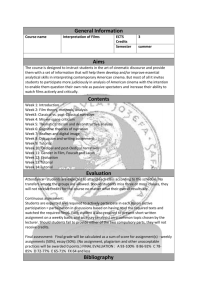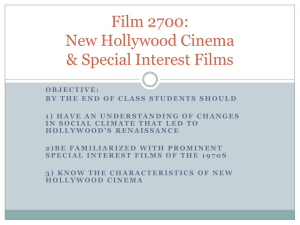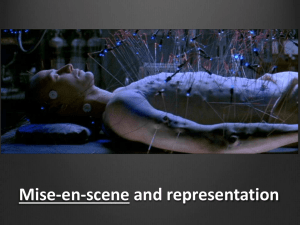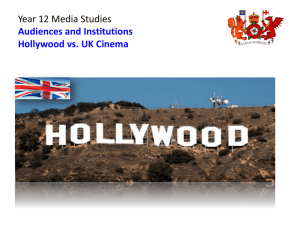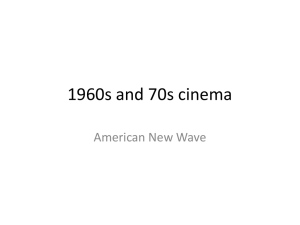US Media - American Film
advertisement
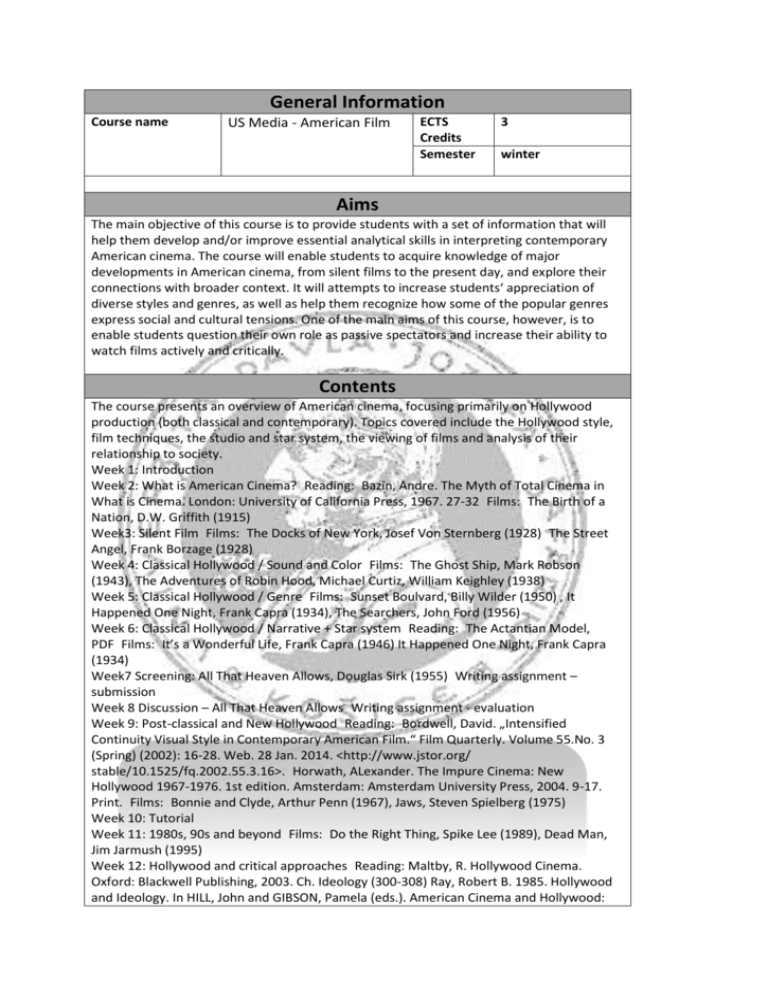
General Information Course name US Media - American Film ECTS Credits Semester 3 winter Aims The main objective of this course is to provide students with a set of information that will help them develop and/or improve essential analytical skills in interpreting contemporary American cinema. The course will enable students to acquire knowledge of major developments in American cinema, from silent films to the present day, and explore their connections with broader context. It will attempts to increase students‘ appreciation of diverse styles and genres, as well as help them recognize how some of the popular genres express social and cultural tensions. One of the main aims of this course, however, is to enable students question their own role as passive spectators and increase their ability to watch films actively and critically. Contents The course presents an overview of American cinema, focusing primarily on Hollywood production (both classical and contemporary). Topics covered include the Hollywood style, film techniques, the studio and star system, the viewing of films and analysis of their relationship to society. Week 1: Introduction Week 2: What is American Cinema? Reading: Bazin, Andre. The Myth of Total Cinema in What is Cinema. London: University of California Press, 1967. 27-32 Films: The Birth of a Nation, D.W. Griffith (1915) Week3: Silent Film Films: The Docks of New York, Josef Von Sternberg (1928) The Street Angel, Frank Borzage (1928) Week 4: Classical Hollywood / Sound and Color Films: The Ghost Ship, Mark Robson (1943), The Adventures of Robin Hood, Michael Curtiz, William Keighley (1938) Week 5: Classical Hollywood / Genre Films: Sunset Boulvard, Billy Wilder (1950) , It Happened One Night, Frank Capra (1934), The Searchers, John Ford (1956) Week 6: Classical Hollywood / Narrative + Star system Reading: The Actantian Model, PDF Films: It’s a Wonderful Life, Frank Capra (1946) It Happened One Night, Frank Capra (1934) Week7 Screening: All That Heaven Allows, Douglas Sirk (1955) Writing assignment – submission Week 8 Discussion – All That Heaven Allows Writing assignment - evaluation Week 9: Post-classical and New Hollywood Reading: Bordwell, David. „Intensified Continuity Visual Style in Contemporary American Film.“ Film Quarterly. Volume 55.No. 3 (Spring) (2002): 16-28. Web. 28 Jan. 2014. <http://www.jstor.org/ stable/10.1525/fq.2002.55.3.16>. Horwath, ALexander. The Impure Cinema: New Hollywood 1967-1976. 1st edition. Amsterdam: Amsterdam University Press, 2004. 9-17. Print. Films: Bonnie and Clyde, Arthur Penn (1967), Jaws, Steven Spielberg (1975) Week 10: Tutorial Week 11: 1980s, 90s and beyond Films: Do the Right Thing, Spike Lee (1989), Dead Man, Jim Jarmush (1995) Week 12: Hollywood and critical approaches Reading: Maltby, R. Hollywood Cinema. Oxford: Blackwell Publishing, 2003. Ch. Ideology (300-308) Ray, Robert B. 1985. Hollywood and Ideology. In HILL, John and GIBSON, Pamela (eds.). American Cinema and Hollywood: Critical Approaches. 1st edition. Oxford: Oxford University Press. 2000, pp. 137-138. Print. Week 13: Tutorials Week 14: Tutorials Evaluation Attendance - students are expected to attend each class according to the schedule. No transfers among the groups are allowed. Should students miss three or more classes, they will not receive credits for the course no matter what their overall results are. Continuous assessment: Students are expected and required to actively participate in each lesson (active participation = participation in discussions based on having read the required texts and watched the required films). Each student is also required to present short written assignment on a weekly basis, and an essay (analysis) on a common topic chosen by the lecturer. Should students fail to provide either of the two compulsory parts, they will not receive credits. To complete the course, students are also required to successfully pass a test at the end of the course. Final assessment: Final grade will be calculated as a sum of score for assignment(s) - weekly assignments (one third), essay (another third), test (final third). (No assignment, plagiarism and other unacceptable practices will be awarded 0 points.) FINAL EVALUATION : A 93100% B 86-92% C 78-85% D 72-77% E 65-71% FX 64 and less Bibliography BAZIN, Andre. The Myth of Total Cinema in What is Cinema. London: University of California Press, 1967. 27-32 MALTBY, Richard. Hollywood Cinema. Oxford: Blackwell Publishing, 2003. Selected chapters. BORDWELL, David. „Intensified Continuity Visual Style in Contemporary American Film.“ Film Quarterly. Volume 55.No. 3 (Spring) (2002): 16-28. Web. 28 Jan. 2014. <http:// www.jstor.org/stable/10.1525/fq.2002.55.3.16>. HORWATH, ALexander. The Impure Cinema: New Hollywood 1967-1976. 1st edition. Amsterdam: Amsterdam University Press, 2004. 9-17. Print. RAY, Robert B. 1985. Hollywood and Ideology. In HILL, John and GIBSON, Pamela (eds.). American Cinema and Hollywood: Critical Approaches. 1st edition. Oxford: Oxford University Press. 2000, pp. 137-138. Print. Recommended literature: BORDWELL, David, THOMPSON, Kristin and STAIGER, Janet. 2002. The Classical Hollywood Cinema: Film Style and Mode of Production to 1960. 6th edition. London: Routledge. 2002. Print. ELSAESSER, Thomas. 2012. The Persistence of Hollywood. New York: Routledge. 2012. Print. ELSAESSER, Thomas, and BUCKLAND, Warren. 2002. Studying Contemporary American Film. New York: Oxford University Press. 2002. Print ELSAESSER, Thomas, HORWATH, A., and KING, N. (eds.). 2004. The Last Great American Picture Show. Amsterdam: Amsterdam University Press. 2004. Print. HAYWARD, Susan. 2000. Cinema Studies: The Key Concepts. 2nd edition. London: Routledge. 2000, pp. 190-195. Print. HILL, John and GIBSON, Pamela (eds.). American Cinema and Hollywood: Critical Approaches. 1st edition. Oxford: Oxford University Press. 2000, RAY, Robert B. 1985. A Certain Tendency of the Hollywood Cinema: 1930-1980. Princeton: Princeton University Press. 1985. Print.

